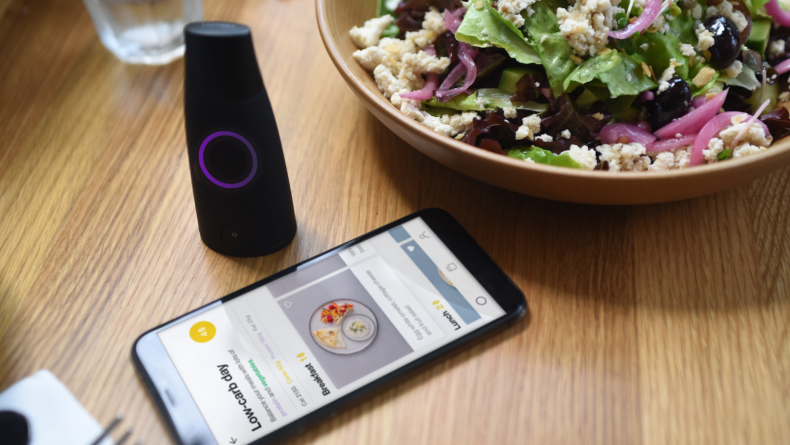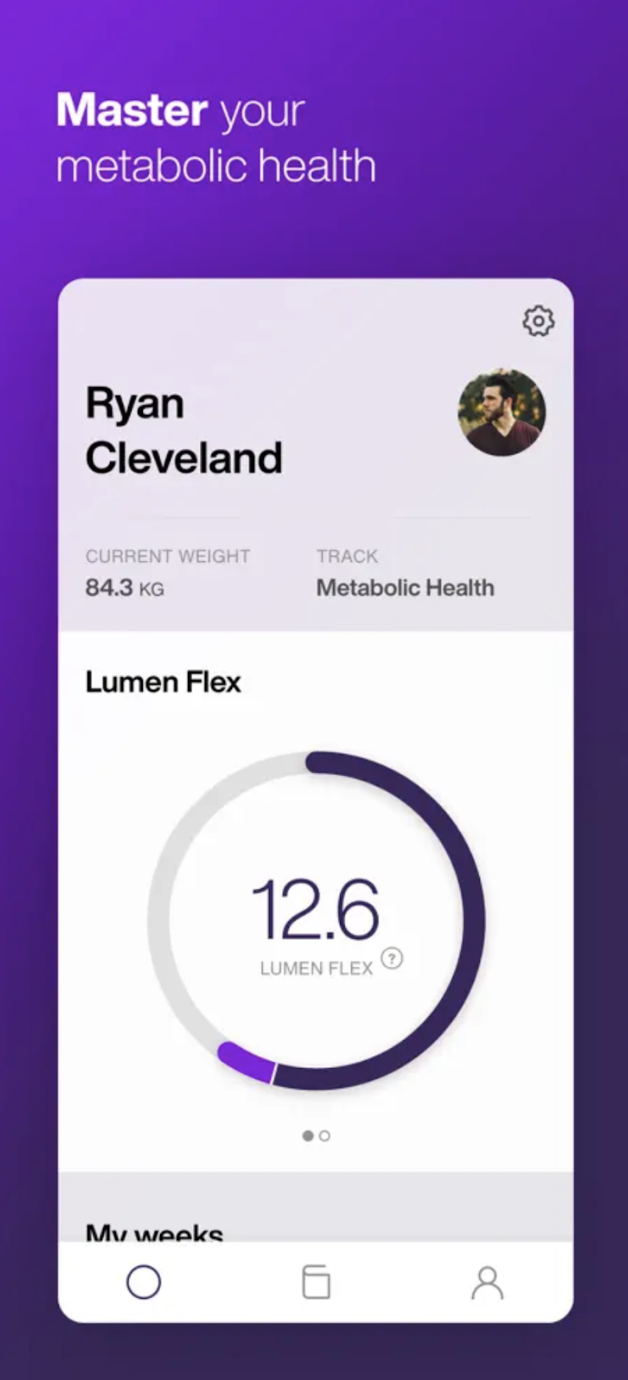Lumen review: Everything you need to know about this trendy metabolism hacking device
Looking to fine-tune your metabolism? Lumen claims it can help you lose weight, enhance fat loss and boost your energy naturally. But can this little device do all that? We talked to three nutrition enthusiasts who’ve used Lumen to find out.

Metabolism plays an important role in your overall health. It’s the process by which your body converts what you eat into the energy you need to function, and impacts everything from weight loss and sports performance to sleep, hormones, and immune function.
The good news is that many things that affect your metabolic health are in your control. Eating well and exercising regularly are two ways you can maintain a healthy metabolism, but people are also experimenting with things like intermittent fasting and metabolism tracking to measure and enhance their metabolic flexibility.
If you’re not familiar with the term, metabolic flexibility is a measure of how efficiently the body can switch back and forth between using fats and carbohydrates for fuel. A growing body of research shows that being more metabolically flexible may be beneficial for weight management, blood sugar, insulin sensitivity, energy levels, sleep, and exercise performance [ 1 2
That’s where Lumen comes in —a handheld breath analyzer that claims it can help you hack your way to a healthier metabolism by providing insights into what energy source you’re using and recommendations around what to eat.
If you’re curious about Lumen, keep reading to learn what this trendy biohacking technology is all about, how it works, and what a few real-life users think of it.

What is Lumen?
Lumen is a health product that measures and tracks your metabolism, sleep, nutrition, and exercise to help you hack your way to a healthier you.
The small, hand-held device uses your breath to analyze your metabolism. By measuring the concentration of carbon dioxide in your breath, Lumen can tell you precisely what type of fuel your body is using for energy.
Lumen can tell you more about how your body processes food through the data collected from this device and their mobile app. It also provides personalized nutrition plans and recommendations for sleep, exercise, and meal timing to help you hack your way to a healthier metabolism and meet your weight loss and fitness goals.
How Lumen works
Lumen’s technology is based on the science of indirect calorimetry, the gold standard for measuring metabolism and an individual's Respiratory Exchange Ratio (RER). The latter reveals the type of fuel you’re running on —carbohydrates, fat, or a combination of both.
The Lumen device uses a simplified version of this technology, a carbon dioxide (CO2) sensor and flow meter, to determine the CO2 concentration of a single breath. The Lumen app then guides you through the breathing maneuver. Starting from the end of a normal exhale, you are prompted to take a deep breath in through the Lumen device, hold it for ten seconds, and then exhale back through the device.
After repeating this 2-3 times, Lumen can determine what type of fuel you’re currently burning based on the CO2 concentration. Here’s a brief breakdown of what that means:
When carbohydrates are your primary source of fuel, more carbon dioxide is produced relative to the consumption of oxygen.
When fats are the predominant fuel, less carbon dioxide is produced.
A CO2 concentration somewhere in the middle suggests you’re burning a combination of both carbohydrates and fat.
Since research shows that eating a lot of quick-digesting carbohydrates later in the day elevates blood sugar and insulin levels (both of which prevent your body from burning fat for energy and may interfere with sleep), Lumen generally recommends eating most of your quick-burning carbs earlier in the day [ 4
For the most benefit, Lumen recommends taking your level multiple times a day, including:
Shortly after waking up in the morning.
Before and after a workout —this can give you insight into whether you need to fuel-up beforehand, and shows you the metabolic impact of your workout afterwards.
1-2 hours after eating, which can give you an idea of how your body responds to certain foods.
After
intermittent fasting
(whether an overnight, whole-day, or alternate-day fast) to see how fasting can shift your metabolism and fuel utilization.
In addition to telling you what fuel source you’re burning, Lumen also provides a personalized daily nutrition plan, meal suggestions and recipes, intermittent fasting insights, and a metabolic food log.
What your Lumen score means
Lumen provides two different scores, the Lumen Level and a Flex Score. Here’s more about what each means.

Lumen Level
The Lumen Level is a daily measurement of which fuel source your body is using. It is the score you receive after using the Lumen breathing device and is based on a scale of 1-5.
Lower scores of 1-2 indicate you’re burning mostly fat, which is ideal in the morning after an overnight fast.
A score of 3 implies you’re burning a combination of fat and carbohydrate.
Higher scores in the 4-5 range imply you’re running primarily on carbohydrates —which you would expect after eating a balanced meal.
Your Lumen can also help guide your pre-workout nutrition and gauge the effectiveness of your workout. For example:
A Lumen level of 4-5 would be ideal before a medium to high-intensity workout since carbohydrates are the body’s preferred fuel source for exercise.
Seeing a drop in your Lumen level (for example, going from 5 to 2) would suggest your body has metabolized those carbohydrates for energy during your workout and is shifting back towards fat utilization.
Using diet and exercise to induce fluctuations in your Lumen Level throughout the day can help you improve your metabolic flexibility.
Flex Score
After two weeks of using Lumen to measure your metabolism, you will receive a Flex Score showing you how flexible your metabolism is. Your Flex Score, which updates weekly, is calculated based on several parameters, including the frequency of your measurements, your morning Lumen levels, and measurements from “boost days'' —high-carb and low-carb days aimed at improving metabolic flexibility.
Here is how you can determine your Flex Score:
Between 0 and 6: your metabolism is not yet flexible.
Between 7 and 14: your metabolism is healthy.
Between 15 and 21: your metabolism is very efficient.
Over time, the goal is to increase your Flex score into the healthy or very efficient range by making meaningful changes to your eating and exercise habits.
Is Lumen accurate?
Lumen states the accuracy of its metabolism measuring device has been scientifically validated. A self-funded study found that the device can estimate metabolic fuel utilization in a comparable manner with a metabolic cart, the gold standard for metabolism measurement in medical and research settings [ 3
How these measurements are then translated into a Flex Score is less clear. This has fostered some criticism, particularly from some experts in the field 1
How much does Lumen cost?
Lumen is a subscription service accessed via the app. The cost of the device is included in the subscription fee. Currently, there are three subscription options:
6 months for $249 (renews at $25/month after 6 months)
12 months for $299 (renews annually after 12 months)
18 months $349 (renews annually after 18 months)
Currently, Lumen offers a 30-day money-back guarantee and $25 off if you sign up to receive their newsletter.
Real-life users' thoughts on Lumen.
To get a sense of how Lumen works and whether it’s worth the hype, we chatted with three individuals who’ve used this trendy technology, including Certified Personal Trainer, L1 Nutrition Coach, and long-time Lumen user Erin Yelle Kelley Magill

Informative metabolic insights can inspire healthy diet changes.
Seeing changes in her readings before and after meals has helped Yelle understand how her body uses food for fuel. According to her, “Lumen has taught me that the fuel that I eat at meals will typically get metabolized by my next meal. If I am consistently taking measurements after a meal, I see a higher reading, but before the next meal, I usually get a lower reading.”
With a better understanding of her metabolism and how her body processes carbohydrates and fat for fuel, Lumen has motivated Yelle to tweak her diet, specifically around what types of carbohydrates she eats and when.
For instance, Yelle said that if she has carbs like pasta, potatoes, or bread in the evening, she typically gets a higher reading level in the morning. She also learned that any alcohol consumption in the evenings would lead to a high score. This has pushed her to eat more starchy carbs first thing in the morning and gradually switch to non-starchy vegetable sources for carbs later in the day.
Simply adjusting her carbohydrate intake during the day has allowed Yelle to achieve lower morning Lumen levels and better metabolic flexibility over time.
Using the device can be demanding.
One of the biggest challenges with Lumen is the time and consistency required to produce accurate data. Taking measurements–which can sometimes require three or more readings multiple times a day for several weeks–is demanding.
Magill found this rigorous testing regimen difficult to maintain for more than a week. According to her, the biggest challenge was her work schedule. “I was working in a hospital for long hours, exercising after work, and visiting friends on the weekends. I spent very little time at home so it was challenging to keep up with using the device,” she said.
Yelle also mentioned time, frequency, and consistency were her biggest challenges as well. While it’s recommended to take measurements in 30-minute time increments before and after exercise and meals, Yelle says that sometimes it is hard to plan in your day.

Lumen may or may not help with weight loss.
Scan a few Reddit threads on using Lumen for weight loss, and you’ll find mixed reviews. Some have found it helpful to eat a more balanced diet and see the positive effects diet and exercise can have on your metabolism, while others have found it too burdensome, complicated, or carb-centric.
Yelle thinks Lumen can be a valuable tool for weight loss because you can more easily see how food, fasting, and exercise affect your metabolism. She has recommended it to clients and says it’s been especially good for those who need to see how foods affect their body and metabolism, though she did note that a good diet and strength training program needs to complement it.
Lumen also offers recipe and food recommendations in the app, and while this may be useful for those looking to lose weight, the food plan doesn’t provide specific meal recommendations tied to your daily macro goals. It’s more of a guide to whether you should be eating low-, moderate- or high-carb that day based on your recent levels and planned activities for that day. Essentially, day-to-day meal planning will still be on your plate.
Furthermore, achieving metabolic flexibility requires eating varying amounts of carbs, which may be a dealbreaker if you’re following a ketogenic or low-carb diet, or require a higher carb intake for sports performance.
Both Fedorov and Magill struggled with Lumen’s carbohydrate recommendations. “My journey with Lumen stopped at the calibration. Calibration required eating carbs at specific intervals, but breaking keto was too much of a price for me,” said Fedorov.
Magill, an avid exerciser, also struggled with the carbohydrate recommendations, which she found too low. She said that “I was always nervous to go too low in carbohydrate with the amount I exercise and also my knowledge on both carb and fat benefits for hormones.”
Lumen recommends varying your daily carbohydrate intake as a way to improve metabolic flexibility, which may not work for everyone. Neither Fedorov nor Magill felt they were able to follow Lumen’s diet recommendations which ultimately led them to stop using the device.
Lumen Pros and Cons
Looking for a quick summary of the pros and cons of using the Lumen metabolism tracker? Here are the most important things you need to know.
Pros
Once calibrated, Lumen can accurately measure your body's primary energy source (fat, carbs, or a combination of both).
Lumen may help you better understand your metabolism, become more efficient at burning fat, and increase metabolic flexibility over time.
The breathing device is small, durable, and can go up to 14 days between charges.
The device connects seamlessly to the Lumen app, which has easy-to-understand education modules, personalized data, monthly cycle, workout, and sleep tracking, weekly goals, daily macro recommendations, and more.
Ample customer support, tutorial videos, and a
Facebook group
to help you get the most out of your Lumen experience.
Cons
Currently, there is no scientific analog for measuring metabolic flexibility; therefore, how Lumen determines your Flex Score is unclear.
The frequency of testing Lumen requires may be challenging for many to stick with long-term, as it may take a month or more to start seeing benefits.
One measurement may require several breaths before you get an accurate reading.
It is a costly upfront investment that requires a subscription to measure and track your data.
Lumen might not work for people with specific carbohydrate goals, such as athletes or those following a low-carb or ketogenic diet.
Intermittent fasting recommendations may not be appropriate for all individuals with specific nutrition needs, such as pregnant women and individuals with diabetes.
The verdict: Does Lumen really work?
From a hardware standpoint, yes, Lumen works. Lumen’s technology has been scientifically validated to accurately measure your body’s primary energy source: fats or carbs. How these measurements are then translated into your metabolic flexibility score (aka Flex Score) is less clear, however, which has fostered some criticism among experts in the field.
From a metabolism “hacking” perspective, Lumen may work—but only if you do. Your Lumen Level can certainly make it easier to understand how important factors, like food, alcohol, sleep, and exercise, affect your metabolism and how your body uses (or stores) the energy you consume. If you use the device diligently and apply Lumen’s data and recommendations to make better diet and lifestyle choices, it can likely help you improve your metabolic health.
However, it is possible to improve your metabolic flexibility the old-fashioned way, too. Weight loss, intermittent fasting, and regular exercise training are some of the most simple but effective ways to do so [ 2
While Lumen may help you achieve weight loss and metabolic flexibility over time, it will still require time, consistency, and diligence, in addition to a healthy and balanced diet.
Disclaimer: The text, images, videos, and other media on this page are provided for informational purposes only and are not intended to treat, diagnose or replace personalized medical care.
Key takeaways:
Lumen measures and tracks your metabolism, sleep, nutrition, and exercise to help you improve metabolic flexibility. The small, hand-held device uses your breath to analyze your body's primary energy source (fat, carbs, or a combination of both).
Metabolic flexibility measures how efficiently the body can switch back and forth between using fats and carbohydrates for fuel. Research shows metabolic flexibility may be beneficial for weight management, blood sugar, insulin sensitivity, energy levels, sleep, and exercise performance [
1
,2
].The device connects seamlessly to the Lumen app, which has easy-to-understand education modules, personalized data, monthly cycle, workout, and sleep tracking, weekly goals, daily macro recommendations, and more.
Lumen’s intermittent fasting and carbohydrate recommendations may not be appropriate for everyone, including pregnant women, individuals with diabetes, athletes, or individuals following a low-carb or ketogenic diet.
Weight loss, intermittent fasting, and regular exercise training are some of the simplest and most effective ways to improve your metabolic flexibility and do not require a metabolic tracking device.
References
Palmer, B. F., & Clegg, D. J. (2022). Metabolic Flexibility and Its Impact on Health Outcomes. Mayo Clinic Proceedings, 97(4), 761–776.
https://doi.org/10.1016/j.mayocp.2022.01.012
Smith, R. L., Soeters, M. R., Wüst, R. C. I., & Houtkooper, R. H. (2018). Metabolic Flexibility as an Adaptation to Energy Resources and Requirements in Health and Disease. Endocrine Reviews, 39(4), 489–517.
https://doi.org/10.1210/er.2017-00211
Lorenz, K. A., Yeshurun, S., Aziz, R., Ortiz-Delatorre, J., Bagley, J. R., Mor, M., & Kern, M. (2021). A Handheld Metabolic Device (Lumen) to Measure Fuel Utilization in Healthy Young Adults: Device Validation Study. Interactive journal of medical research, 10(2), e25371.
https://doi.org/10.2196/25371
Yoda, K., Inaba, M., Hamamoto, K., Yoda, M., Tsuda, A., Mori, K., Imanishi, Y., Emoto, M., & Yamada, S. (2015). Association between poor glycemic control, impaired sleep quality, and increased arterial thickening in type 2 diabetic patients. PloS one, 10(4), e0122521.
https://doi.org/10.1371/journal.pone.0122521






